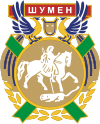Shumla
|
Shumen Шумен |
|||
|---|---|---|---|

A view of Shumen from above
|
|||
|
|||
| Location of Shumen | |||
| Coordinates: 43°17′N 26°56′E / 43.283°N 26.933°E | |||
| Country | Bulgaria | ||
|
Province (Oblast) |
Shumen | ||
| Government | |||
| • Mayor | Lyubomir Hristov (GERB) | ||
| Area | |||
| • City | 136.358 km2 (52.648 sq mi) | ||
| Elevation | 184 m (604 ft) | ||
| Population (2015) | |||
| • City | 77 709 | ||
| • Urban | 93 160 | ||
| Time zone | EET (UTC+2) | ||
| • Summer (DST) | EEST (UTC+3) | ||
| Postal Code | 9700 | ||
| Area code(s) | 054 | ||
| License plate | H | ||
| Website | Official website | ||
Shumen (also spelled Shoumen or Šumen, Bulgarian: Шумен), is the tenth largest city in Bulgaria and the administrative and economic capital of Shumen Province.
The city was first mentioned as Šimeonis in 1153 by the Arab traveler Idrisi. The name is probably from Bulgarian shuma '(deciduous) forest', though some believe (Konstantin Jireček) that it comes from the name of the Bulgarian emperor Simeon the Great. In the following periods, the city was mentioned with different variants, such as Şumena, Şumna, Şumular, Sumunum, Şumnu and Şumen.
Earliest reports for Shumen fortress date back to the early Iron Age. From the 12th century BC is the first fort, surrounding accessible parts of the area. Archaeological surveys, conducted in 1957, 1961 to 1987, determined the chronological periods, the lifestyle and the livelihood of the inhabitants of the fortress. It had a wall thickness of about two meters, built of rough stones. In the 5th century BC second wall was built in front of the former. In the 2nd century the Romans built a military fortress on the ruins of the Thracian fortifications. The construction of the wall is already bonded to mortar; a tower was constructed above the gate; square tower was built to the west and semicircular to the south. In the 4-5th centuries the entire hill was fortified with a new wall with nine towers. Between the 8th and the 10th century the fort was renovated, for the purpose the Roman wall and towers were used and to the northeast was built a new wall with two towers.
In 681 khan Asparukh incorporated the territory into the First Bulgarian Empire. In 811 Shumen was burned by the Byzantine emperor Nicephorus and he was killed at the Battle of Pliska, when khan Krum of Bulgaria encased Nicephorus's skull in silver, and used it as a cup for wine-drinking. The Bulgarian fortification of the 7-10th centuries developed into a feudal city with castle with surrounding inner and outer defensive zones, in which can be counted 28 towers and bastions, three gates and five small porticoes, with many churches and workshops (12th to 14th century). During the golden age of Bulgarian culture under Simeon the Great (893-927), Shumen was a centre of cultural and religious activity, and may have borne the name Simeonis. During the Second Bulgarian Empire, Shumen was a significant military, administrative and economic center, displacing even the old Bulgarian capital Preslav and developing outside the fortress. In the medieval city of Shumen the main religion was the Orthodox Christianity, evidence of which were the found in the outline of the walls seven churches, commemorative coins with the image of crosses, angels and the numerous findings of Orthodox crosses separately, as well as their image on rings and on other artefacts, found in the graves and the homes. Change occurs only after the Ottoman conquest of the city in the 15th century, when Islam was introduced.
...
Wikipedia



